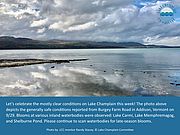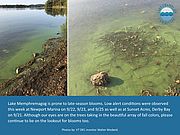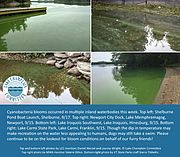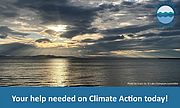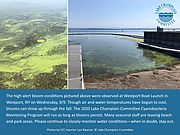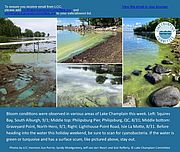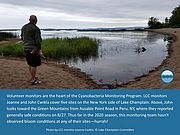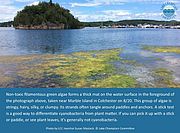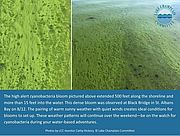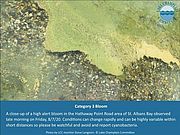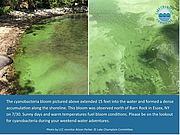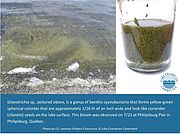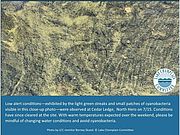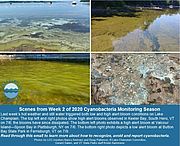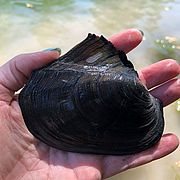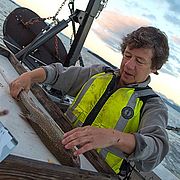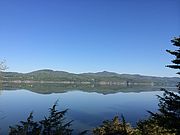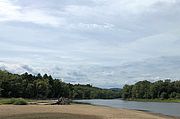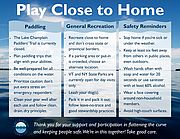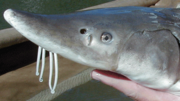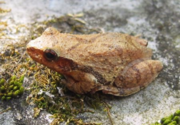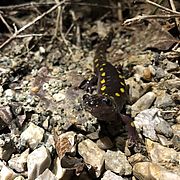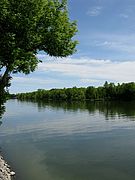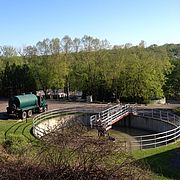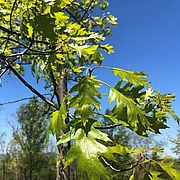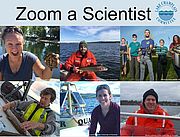Good conditions prevailed on most of Lake Champlain this week. A few notes of caution however: high alert blooms continue to persist at Lake Carmi and low alert blooms were observed on Lake Champlain’s Inland Sea and the South Lake as well as Lake Memphremagog and Shelburne Pond. When you’re checking out the foliage on the hillsides be sure to check the water for color too as blooms can still appear late in the season. Read...
News from Selected Month
Good conditions were observed this week in Missisquoi Bay, Main Lake Central, Main Lake South, and the South Lake on Lake Champlain and on several inland lakes where monitors are still able to report. Low level alerts were reported on the Inland Sea and Malletts Bay and Lake Iroquois and Lake Memphremagog. Hight alerts were witnessed on St. Albans Bay, Main Lake North, Halls Lake, Lake Carmi and Shelburne Pond. The sunny warm weather anticipated this week may trigger more blooms. Read...
We are more than halfway through the 2020 monitoring season. Report numbers will be lower as beaches and parks close up and seasonal staff leave their posts. However, it’s still a great time to recreate in and around waterways provided you’re well prepared for conditions. Please remember that cyanobacteria can still show up despite the cooling temperatures. Keep an eye on conditions whenever you are near the water and be especially mindful if you’re walking or wading shoreline areas with pets. Read...
On Tuesday evening, Governor Scott vetoed the Global Warming Solutions Act. The bill, which was overwhelmingly passed by both the Vermont House and Senate earlier, would require Vermont to reduce climate pollution and create a community-driven equitable plan to move off of fossil fuels towards energy independence. The measure will create jobs, improve community resilience, use natural systems and working lands to capture and store carbon, and create a deadline-driven process to hold the State accountable. A summary of the Solutions Act is below. Read...
There’s a nip of fall in the air and tinges of color on mountain slopes this week as some schools re-open, docks get pulled and state and municipal parks and beaches begin to close out their summer season. The change in temperature may decrease blooms in some areas and trigger them in others. Both inland waterways and Lake Champlain are subject to late summer and fall blooms so please continue to keep a watchful eye on the water and share information with others to raise awareness of cyanobacteria. Read...
While the cyanobacteria tracker map was dominated by green dots last week, too many red dots evidencing blooms are showing as we head into Labor Day weekend. While good conditions were observed at Lake Champlain’s Malletts Bay, Main Lake South, and South Lake and at numerous inland waterways, cyanobacteria blooms showed up in Missisquoi Bay, St. Albans Bay, the Inland Sea, Main Lake North and Main Lake Central on Lake Champlain as well as at Lake Carmi, Lake Morey and Shelburne Pond. Blooms can pop up or persist well into the fall so please continue to check conditions carefully whenever recreating near waterways. Read...
The cyanobacteria tracker was mainly populated by green dots this week indicating generally safe water conditions. However, blooms were observed in select locations both early and late in the week. Benthic cyanobacteria were also reported from a stream and private pond in Vermont. The cooler temperatures and rain ahead may lessen bloom frequency but cyanobacteria is still likely to show up in waterways for a while yet. Please keep a watchful eye and use the resources and tools in this email to help you learn how to identify, avoid and report cyanobacteria. Read...
Monitors filed 151 reports this week from Lake Champlain and inland lake sites. The cyanobacteria tracker map shows lots of green dots this week for generally safe conditions. However, blooms are still present in some areas of Lake Champlain and inland lakes. Read...
It’s been a tumultuous week with hot weather, intense rains that flushed nutrients and partially treated wastewater to Lake Champlain, and some high winds that knocked out power. In the midst of it all cyanobacteria monitors collectively filed 212 reports from Saturday August 8 through 1:30 p.m. on Friday August 14! Read...
The Lake Champlain Committee (LCC) and partners received 186 monitor reports last week from August 1 through 4:00 p.m. Friday August 7, 2020. Good conditions were observed in Lake Champlain’s Missisquoi Bay, Malletts Bay and the South Lake while blooms were reported for areas of St. Albans Bay, the Inland Sea, Main Lake North, Main Lake Central, and Main Lake South. Mixed conditions continued in Lake Carmi. Read...
The Lake Champlain Committee (LCC) and partners received 154 monitor reports this past week from Saturday July 25 through 1:45 p.m. Friday July 31. Good conditions were observed in Lake Champlain’s Missisquoi Bay, Main Lake North, Malletts Bay and the South Lake while blooms were reported for areas of St. Albans Bay, the Inland Sea, Main Lake Central, and Main Lake South. Mixed conditions continued in Lake Carmi this week and Lake Raponda also experienced a low alert. Read...
We received 183 monitoring reports last week through Lake Champlain Committee (LCC) Cyanobacteria Monitoring Program from Saturday July 18 through mid-afternoon Friday July 24. Due to the high volume of reports and some technical issues we weren’t able to send you the compilation until today. Read...
It’s been another busy week for the Lake Champlain Committee (LCC) Cyanobacteria Monitoring Program with 152 reports from Lake Champlain and inland lakes from Sunday July 12 through Friday July 17 at 1:30 pm! Good conditions were observed in Malletts Bay and Missisquoi Bay, there was one alert report in Main Lake Central and one in Main Lake North with mixed alert conditions in St. Albans Bay, the Inland Sea, and Main Lake South. Lake Carmi also had cyanobacteria alerts. Read...
Thank you for signing up to receive the Lake Champlain Committee’s (LCC) cyanobacteria monitoring reports! Monitoring will run through the early fall. Each week we’ll send you an update about conditions our monitors are finding around Lake Champlain and several inland lakes. This week’s report covers results from Sunday July 5 through late afternoon Saturday July 11. We had 159 reports that ranged from clear water conditions (perfect for cooling off in) to turquoise blooms that closed down access areas. Future reports will generally be sent to you on Fridays. Read...
If you’ve paddled, taken a swim, or cast a fishing line in the waterbodies of the Lake Champlain Basin, you’ve likely spent time among one of the most enigmatic groups of aquatic animals in our region: native freshwater mussels. They’re quirky—sporting hatchet-like shells and traveling by a single fleshy foot, yet familiar—related to the invasive zebra mussel and edible bivalves such as littleneck clams and scallops. Read...
Did you miss a “Zoom a Scientist” session? Don't worry! All the webinars are recorded and can be accessed via Youtube! Want to learn more about microplastics, climate change, or aquatic invasive species? Wonder how prepared we are for an oil spill or what fish do in winter? Curious about how scientists use drones and photogrammetry to learn about the lake? Read...
Vermont environmental advocates sent a letter to Governor Phil Scott on 4/6/20 thanking him for his efforts to address the unprecedented COVID-19 emergency, and urging him to uphold environmental and public health protections during the crisis, along with public accessibility and transparency.
Read...May is American Wetlands Month! Join us in celebrating our wetland wonders, from swamps and shores to floodplain forests and fens. Check out the LCC Facebook page where we’ve been posting about a different Lake Champlain watershed wetland every week. Read...
A sit spot is an outdoor site where you can go to slow down, soak up what’s around you, and appreciate nature. It is a location in your backyard or close to home—this is not a get-in-your-car activity—where you can observe changes in the natural world over time. With stay-close-to-home guidance in place, this activity can be a welcome refuge from the current uncertainty. Visit your sit spot on a timeline that works for you: daily, every other day, or weekly. We suggest returning to your sit spot at the same time of day, so you can intimately learn the patterns and rhythms of your site. Read...
Spring is a great time to recreate—blue skies, vegetation glowing green, woodland flowers bursting forth, birds in flight and song—all call us to get outside! With the recent easing of COVID-19 related restrictions on travel, we are all anxious to go further afield to exercise our bodies and lift our spirits outdoors. Please take precautions, Play Close to Home and remember that water is still deadly cold. Thank you for following these tips to help flatten the curve and keep people safe. We're in this together! Be well, everyone. Read...
Lake sturgeon can be unintentionally caught by anglers during May and June as they head upstream to spawn in the waters where they were born. The stress incurred from being hooked can inhibit their ability to reproduce. Lake sturgeon are a threatened species in New York and an endangered species in Vermont. There is no open season for lake sturgeon and possession is prohibited, so anglers should not be targeting these rare fish. Read...
Is it a bird? No. A cricket? Close! The shrill chorus of spring peepers is the chime of spring. They are among the smallest and certainly one of the most common species of frog in the Lake Champlain watershed. You can discern a spring peeper up close by a dark imperfect X pattern, contrasted against shades of brown, on its back. The “X” begets its scientific species name crucifer which means, “one who carries a cross.”
Read...“P” stands for phosphorus. It’s a naturally-occurring element, that when present in excess, disrupts critical ecosystem functions and can cause cyanobacteria blooms. It’s carried into the lake through a host of sources, including the runoff from lawns and gardens. According to the 2018 State of the Lake and Ecosystem Indicators Report, phosphorus from developed lands accounts for approximately 16% of the total phosphorus load to Lake Champlain each year.
Read...Chartreuse—a luminous yellow-green color—currently punctuates wetlands and wetland edges throughout our region in the form of American false hellebore (Veratrum viride). The herbaceous perennial belongs to the lily family and is typically found in wet places such as stream corridors, moist meadows, and swamps. Mature plants can grow as tall as six feet.
Read...Conservation Biologist Steve Faccio of the Vermont Center for Ecostudies (VCE) visits a local vernal pool each week throughout the spring of 2020. In a series of seven short videos taken from April 1 through May 8 he introduces viewers to the defining characteristics of vernal pools, discusses the overwintering and breeding activities of wood frogs, and provides an underwater tour of salamander eggs, fairy shrimp, tadpoles, Caddisfly larvae, and Eastern Newts. Read...
"From Lake Champlain to the Richelieu River and the St. Lawrence, a panel of Canadian experts explores our connections and common interests in our water. Saving Our Waters is a documentary series covering steps toward keeping our waterways clean; the impacts of phosphorus and other contaminants; and using the science behind the issues to derive solutions that have positive impact on our communities." Read...
Look no further than the vast system of pipes beneath our feet—sewers—for an alternative to monitoring for viruses like COVID-19 person by person. Wastewater could provide localized data about coronavirus levels and create an early warning system for future outbreaks. In Detroit, MI, for example, an outbreak of hepatitis A was detected a week in advance of an increase in confirmed cases, by extracting the genetic material from the wastewater. Read...
Entomologist Douglas Tallamy is urging Americans “to go native and go natural” and move away from the monoculture of a lawn. He’s an advocate for native plants as a way of preserving North America’s natural ecology. His recommendations for rewilding the country include: Read...
We hope you’re healthy and finding ways to nurture yourself during these challenging times. We are looking forward to diving into the lake to refresh our spirits once temperatures warm and travel restrictions ease. In the meantime, we thought we’d share the expanded line up of “Zoom a Scientist” programs that our friends at Lake Champlain Sea Grant have put together. You can tune in virtually through Zoom every Tuesday and Friday from noon to 1:00 p.m. to learn more about the lake!
Read...At LCC we love science and water—and feel grateful to immerse ourselves in those topics every day. Click here to read the Vox article about the really cool science behind why soap and water is a killer combo in protecting us against Covid-19.
Read...
